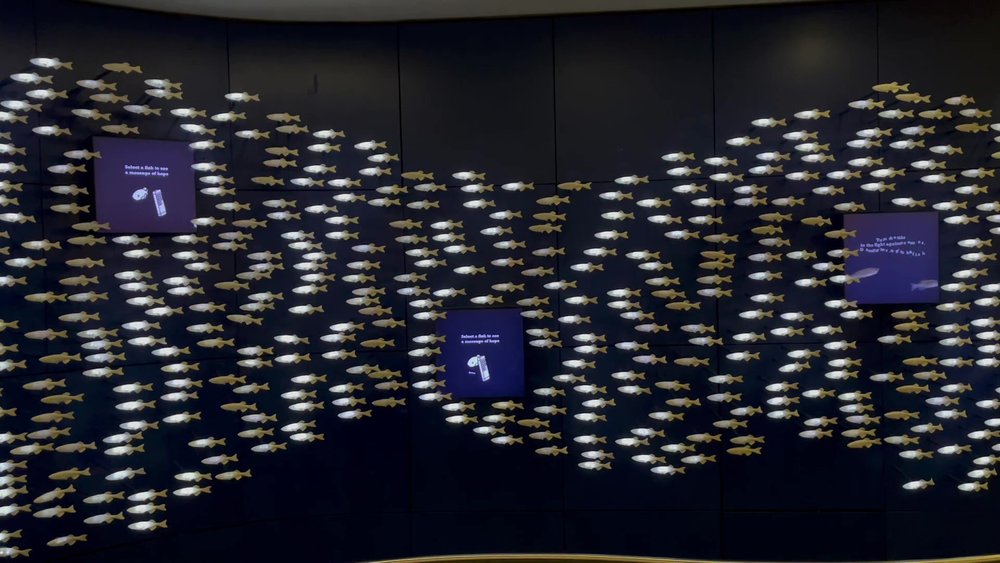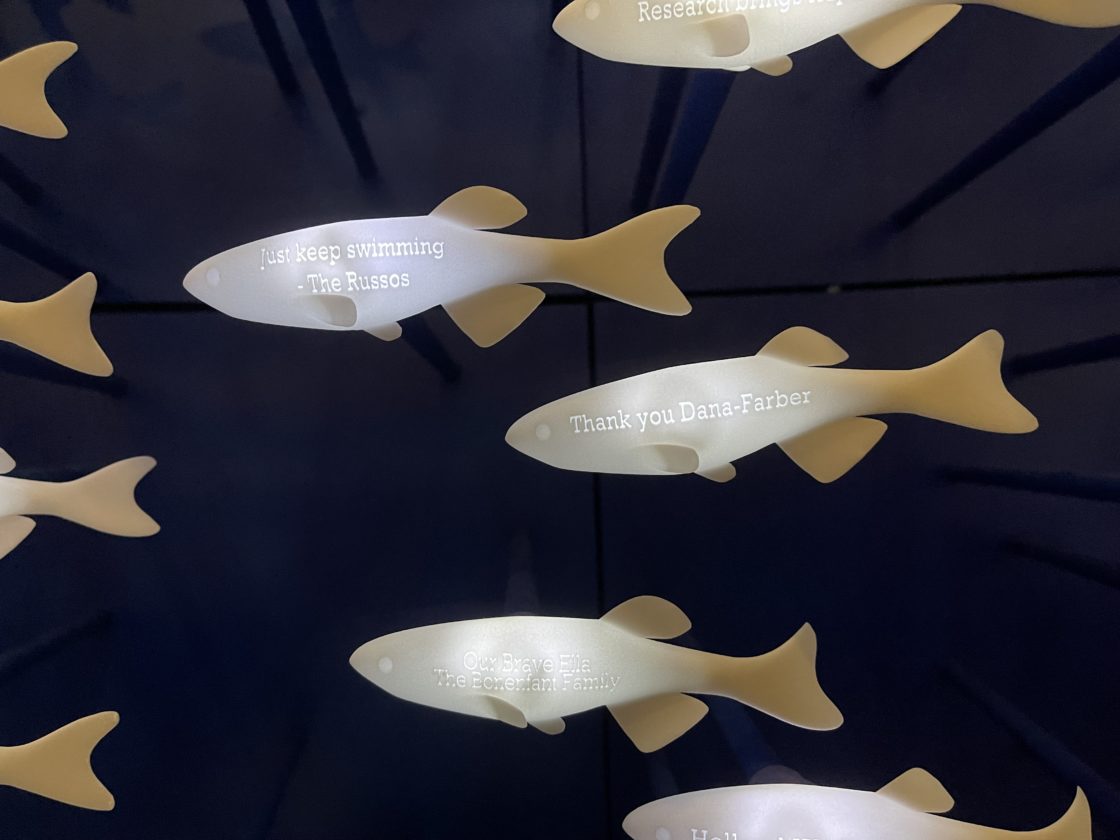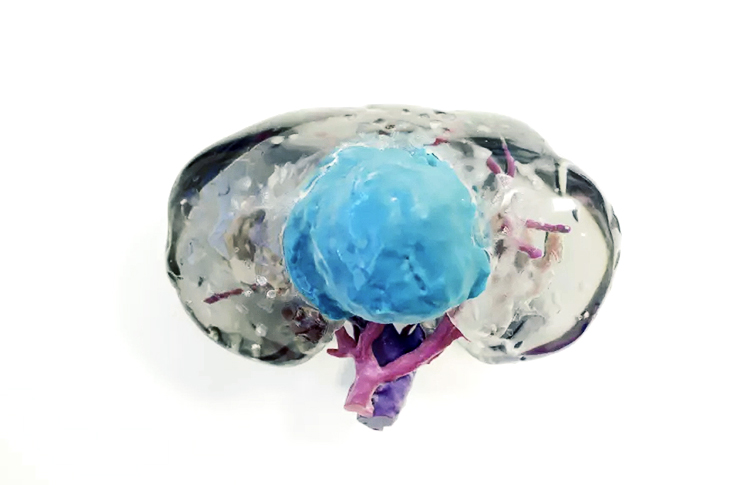
For most employees, walking into work each day means filing past the typical logos and well-intended decor; however that is certainly not the case at Dana-Farber Cancer Institute where entering the lobby means being greeted by a school of no less than 477 zebrafish. 3D printed in a large-scale installation, the unusual fish are the focus of an incredible piece of artwork inspired by critical cancer research, and the many hundreds who gave donations.
Why Zebrafish Are a Powerful Symbol in 3D Print at Dana-Farber
It doesn’t take long to understand why the 3D printed Zebrafish Display is featured so prominently at Dana-Farber. The tiny fish, found plentifully in even the tiniest streams and rivers of Southeast Asia has played an amazing role in biomedical research since the early 1970s. The research has only continued to expand, from helping scientists to identify and learn more about cancerous tumors to delving into the regenerative aspects of the zebrafish. This also applies to areas like the heart and cells, as well as their tails or eyes, with regrowth occurring so rapidly it’s almost like magic.
It’s no wonder that medical scientists are so interested in the tiny minnows, and it makes sense that back in 2012 when Dana-Farber and their consulting engineers and designers put their heads together, they came up with the creative idea for a school of fish swimming forward in 3D print for a wall installation. This vision was intended to parallel the activity of so many people coming together with donations, creating a large cumulative sum to fund ongoing cancer research, to save and enhance lives, as well as preventing, diagnosing, and treating countless types of cancer currently impacting the human race.
Although the 3D printed Zebrafish Display has stood the test of time at Dana-Farber, growing pains, along with a desire for newer technology prompted a ‘refresh.’ The overhaul also meant bringing back together some of the same team who worked on the original project, such as Shapeways, and Nathan Lachenmyer, now the Director of Technology at Sitara Systems.
“The overarching theme was that Dana-Farber wanted to create a really big change in cancer research through the efforts of lots of smaller sums from individual people working together. So from a design perspective, that kind of led us to thinking about other types of groups like schools of fish,” said Lachenmyer.

Nylon 12 [Versatile Plastic]: Still the 3D Printing Material of Choice
Because the original 3D printed Zebrafish Display grew so large, and over such a long period of time, many of the pieces were showing their age at different rates in terms of wear or coloring. Consequently, the second round of design and production included 3D printing the fish again so that they all matched in bright white, along with removing the current sensors and turning them into a touch-free system lighting up the fish and displaying donor information transmitted wirelessly to visitor smartphones.
“The idea was to eliminate the original touch sensors because obviously, Dana-Farber is a cancer institute, and a lot of their patients are immunocompromised,” said Lachenmyer. “They wanted to do something new with the installation wall that would not risk the health of their patients who are in the building all the time.”
Dana-Farber was interested in 3D printing all 477 fish, which meant a lot of uploading and transferring files, and conferring on the proper materials and technology. Even though other options were considered, they still settled on Nylon 12 [Versatile Plastic] and SLS 3D printing technology again.
Each 3D printed zebrafish started out as a blank white shape with the installation taking form in 2012. As each one was purchased by a donor, they were placed on the wall with the donor’s names and messages included on them.
“The second time around we kind of broached the topic of changing materials or colors, but Nylon 12 was still a great choice because of the aesthetics, and especially because it works so well with the LED light shining through,” said Lachenmyer.
“We had a great rapport in working with Shapeways in 2012 as well into 2022, examining the choices for materials and finishes.”

Models Are Helpful for Various 3D Printing Medical Applications
3D printed models are becoming much more common in medical applications, and Shapeways has been privileged to be involved in some incredible projects that continue to make impacts in the lives of patients around the world.
3D printed medical models are used in so many different ways, from helping to diagnose conditions to using them as visual aids for educating patients and their families. They are also used as training devices for experienced surgeons taking on new and complicated procedures–as well as medical students on the learning curve.
As this project evolved, however, it quickly became apparent that the 3D printed models were being designed and put to use in an unprecedented, exceptional way. Everyone working on the project was willing to put in special effort to emphasize the ongoing importance of cancer research.
The installation is permanent at Dana-Farber, and undeniably a very important aspect of their building as they pay homage to the tiny model organisms and 477 donors who realize the importance of cancer research at a facility known for their excellence in medical research, as well as education.
About Shapeways
Enjoy the benefits of this advanced technology and a wide range of materials from Shapeways for 3D printing your creations with accuracy, complex detail, and no minimum or limits in terms of mass customization or single part orders. Shapeways has worked with over 1 million customers in 160 countries to 3D print over 21 million parts! Read about case studies, find out more about Shapeways additive manufacturing solutions, and get instant quotes here.

